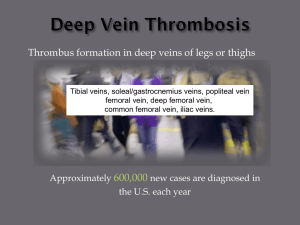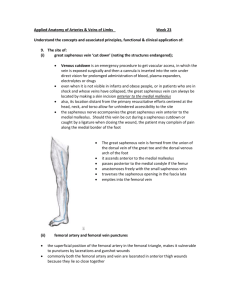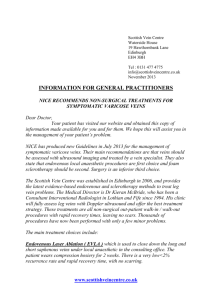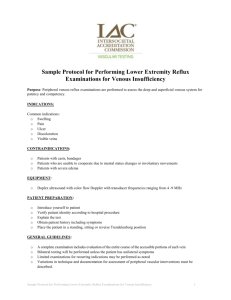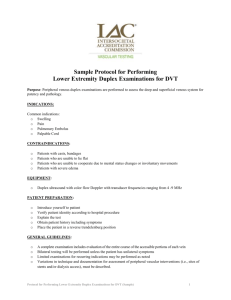venous anatomy of the lower limb - S.I.F.
advertisement
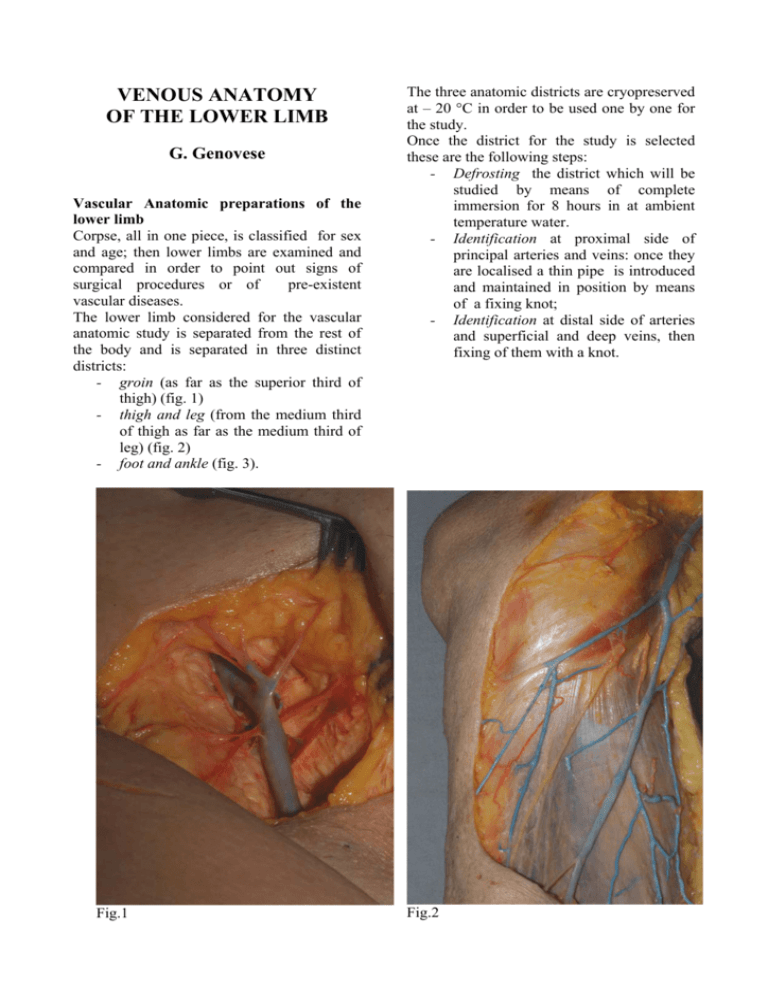
VENOUS ANATOMY OF THE LOWER LIMB G. Genovese Vascular Anatomic preparations of the lower limb Corpse, all in one piece, is classified for sex and age; then lower limbs are examined and compared in order to point out signs of surgical procedures or of pre-existent vascular diseases. The lower limb considered for the vascular anatomic study is separated from the rest of the body and is separated in three distinct districts: - groin (as far as the superior third of thigh) (fig. 1) - thigh and leg (from the medium third of thigh as far as the medium third of leg) (fig. 2) - foot and ankle (fig. 3). Fig.1 The three anatomic districts are cryopreserved at – 20 °C in order to be used one by one for the study. Once the district for the study is selected these are the following steps: - Defrosting the district which will be studied by means of complete immersion for 8 hours in at ambient temperature water. - Identification at proximal side of principal arteries and veins: once they are localised a thin pipe is introduced and maintained in position by means of a fixing knot; - Identification at distal side of arteries and superficial and deep veins, then fixing of them with a knot. Fig.2 - - - Fig.3 Visualization of vascular apparatus by means of endovascular injection of opportunely diluted coloured latex: blue colour is used for veins and red colour for arteries (fig. 3); Endovenous injection: it is executed firstly after washing by water injection in distal-proximal direction to simulate venous outflow in order to avoid venous valves opposition at uniform latex diffusion. Then in opposite way (proximal-distal), of course, arteries are injected after water washing; Dissection of anatomic preparations after two hours in order to allow latex setting in injected vessels; Skeletization of vessel, isolating them from surrounding tissue with cautious progression (Fig 4-5). Fig.4 Fig.5 ANATOMY Venous system of the lower limb is formed by a venous net originating in the distal foot and draining, in their way towards heart, venous blood from various districts, converging each other in order to connect at limb root (Scarpa’s triangle, 3-4 cm beneath inguinal ligament) in one trunk, common femoral vein which goes on above inguinal ligament as extern iliac vein, superficial root of common iliac vein. Anatomically in lower limbs two systems can be considerate: a deep and a superficial system, divided by aponeurotic fascia; so venous systems can be defined underfascial venous system and overfascial venous system respectively. Valves Both systems are provided with valves (pocket-shaped formation) generally bicuspidal, rarely tricuspidal, formed by an extraversion of endothelium and tunica media; muscular bundles are connected at the valve base and allow, together with a hardening of the wall in this area, to oppose in a considerable way gravitational pressure of blood column that goes on toward heart. Valves have an edge adhered to endothelium crescent-shaped (axial face) and a free concave edge, swaying in the vessel lumen (parietal face). Over the adherent edge of each valve, venous wall appears thin and dilated (because of an increase of blood column gravitational pressure); in this way it forms a sinus which appear outer wall as a roundtopped hill (fig. 8) of the wall it is correspondent, internally, to the concavity limited by the valvular pocket. Superficial endothelial layer of valvular edge is formed by two laminas: one of them covers the parietal face, the other covers the axial face: both join together in connection with the free edge. A light layer of elastic fibrillary connective tissue inside is interposed between the two laminas; sometimes muscular fibrocells with bundles particularly developped are present together with active valvular functions. Fig.6 In both systems (deep and superficial) the number of valves decrease progressively from the lower part to the upper part and they are rarely represented or totally absent as in cava vein. It is evident that the few valves of femoral vein and the first two of long saphenous vein support all the weight of blood column and they may, therefore, more easily with passing time in life, stave in. Moreover the particular anatomo-topographic situation of left iliac vein compressed by right iliac artery at their intersection with evident difficulty of outflow: all this facilitate the outbreak of varicose disease in individuals genetically predisposed with a major incidence in the left lower limb. Perforating veins Both venous systems (deep and superficial) are bound by transfascial communications defined “perforating veins” which, if in physiologic conditions are able to facilitate Fig.8 Fig.7 Fig.9 blood outflow of superficial vein (about 10%) towards deep system, in pathologic conditions (e.g. in post thrombotic syndrome) they assume a determinant importance in the evolution of chronic venous insufficiency. All perforating veins are provided of directional valves in order to facilitate blood outflow from superficial towards deep system but above all to prevent reflux from deep to superficial system in all the lower limb, except the major part of the plantar venous plexus were the flow of deep venous system goes into dorsal superficial veins. We may conclude comparing perforating vein system to a fulcrum of scales of two systems the superficial and the deep, whose role certainly important in physiologic conditions become fundamental in pathological conditions. In order to define a unique language it is important: A perforating vein perforates muscular fascia (and it is, often, accompanied by a small Fig.10 Fig.11 artery and sometimes by a sensitive nerve) connecting directly two different venous system: the superficial and the deep. A communicating vein connects two different district of the same venous system: superficial or deep (e.g. in superficial system Giacomini’s anastomotic vein connects short with long saphenous vein; in deep system: femoral medial circumflex vein connects ischiatic vein with deep femoral vein); A collateral vein is a minor vein that together with similar veins converges in collector veins of the same district, in the superficial or in the deep system. Fig.12 Etiopathogenetic hypothesis about venous ulcer As can be noticed from anatomical preparations (in succession during preparation), in the medial malleolar anatomical district up to the inferior third of leg two small satellite artery for each perforating vein (Fig. 10-12) are evidenced or a single arterial trunk greater and straight away out of the fascia get entangled in spiral around the perforating vein (Fig. 11) divide itself (Fig. 12) in two or smallest arteries in a crawling way on the external surface of fascia; subsequently they become superficial branching out heavily first in the subcutis (Fig.13) and subsequently in the hypodermis and dermis (Fig. 14) and at last assuming a terminal distribution. In the two superior districts (thigh and leg), otherwise, every perforating vein has a unique perforating artery (Fig. 7). Fig.14 Perforating vein is unique outer muscular fascia, but originates from the union of two trunks which depart from two satellite veins of deep system (Fig.15). Fig.15 Fig.13 No theory nowadays is able to explain the reason way varicose ulcers develop in the same anatomic region: hypothesis more accredited it was that of the increased hydrostatic pressure and the presence in that region of a great deal of perforating veins. Therefore these two hypothesis don’t explain the reason why a patients, who suffer from many years of varicose veins, suddenly develop a trophic lesion; of course this acute event may have a non chronic situation as a pathogenetic moment. The described anatomical study, experienced in various post mortem examinations, demonstrated firstly the alteration of two small satellite artery for each perforating vein in the upper malleolar region and in the inferior third of the leg – medial face. The reason why of this situation it is yet unknown but can be supposed with a certain confidence that primum movens of the trophic lesion may be an ischemic event, caused by a progressive compression of dilated vein on arteries: these are trapped and strangled by the dilated perforating vein(vedi Fig.15) and between the vein and the fibrous ring of muscular fascia, non-stretch and adherent. These small but numerous (Fig.16) vessels are terminal and they feed skin wall in the medial back malleolar region so that a low arterial flow can create an ischemic state and consequently the lesion. Fig.16 It is important to observe that the described hypothesis don’t represent an annulment of the hypertensive microangiopathy hypoxia but it is its integration: in fact hypoxia is present in all the distal part of the leg whereas ischemic hypothesis concerns specifically the preferred critic point of ulcus cruris. Therefore, Anatomy, always, little studied or not critically accepted and referred to a oldest studies, gives interesting data which may open new pathways for more appropriate therapies. This theory will have to be further on validated with more wide researches and studies but can now be a stimulus of careful and serious consideration. Deep Veins They origin in the sole and the back of foot. In the sole: digital plantar vein, joining in two in interdigital space form plantar metatarsal veins that join the deep plantar venous arch from which lateral plantar veins originate which join the two medial plantar veins. In the back: dorsal metatarsal veins converge in the two anterior tibial veins. Anterior tibial veins and posterior tibial veins (which receive in the leg fibular veins) have precise characteristic of propulsive veins and are provided of valves; in their way are adjacent to the homonymous arteries and they converge at the height of the soleus tendineous arcade forming the popliteal vein which pass in the popliteal cavum in a unique common sheath with homonymous artery to which adhere solidly and it’s the reason why it is always open. It has moderate characteristic of propulsive vein and it is provided with 1-2 valves. Popliteal vein goes on, therefore, in the adductor canal with the superficial femoral vein which, satellite of homonymous artery, passes with this in the Scarpa’s triangle and after receiving the deep femoral vein (which drain blood from muscle of the medial region of thigh) forming the common femoral vein, goes over inguinal ligament in the extern iliac vein. Therefore common femoral vein is the principal collector of all the venous system of the lower limb and in the adult has typical characteristic of propulsive veins and it is provided with 3-4 valves. Besides the deep femoral vein, long saphenous veins and some subcutaneous veins of abdominal wall are tributaries of common femoral veins. Superficial Veins These veins originate in the sole and in the back of the foot too and they are independent (not satellites of arteries). In the sole: superficial plantar digital veins, emerging in fingers from the venous net of finger-tips, pass along finger edges and joining together form skin plantar venous net with a distal convexity; in the concave side of the arch skin plantar venous net flow whereas distal segment of arch go on flowing in marginal veins (medial and lateral) of foot. The net communicate with deep plantar veins, whereas the arch communicate with dorsal digital veins through intercapitolar veins passing through creases between fingers. In the back: dorsal digital veins, originate in the subungueal net, pass along finger edges, converge at root of common digital veins which converge in superficial dorsal venous arch in the concavity of which dorsal venous net of the foot converge. From both sides, medial and lateral, of the arch medial (or dorsal) marginal vein and lateral (or dorsal) marginal vein which receiving, along the foot’s edges plantar and dorsal net branches, Short and Long Saphenous veins originate. Short Saphenous Vein It originates as a continuation of lateral marginal vein just behind lateral malleolus, it rises along lateral edge of calcaneal tendon and moving towards its posterior face, passes along medial line of the leg in the furrow between the twin muscles; it reaches the inferior part of popliteal space and becoming bent ahead join popliteal vein. In same cases, however, short saphenous vein goes on farther adductors canal and join femoral vein at various levels, or it can join Giacomini’s anastomotic vein and then join long saphenous vein (Fig. 8). Short saphenous vein has the characteristics of a propulsive veins and may have even 8 valves; more important anatomical particularity from a surgical point of view is its passing: in the subcutaneous connective tissue from its emergence as far as the medium third of leg perforate crural fascia becoming subfascial. At its origin it receives lateral calcaneal vein and some anastomotic branches with lateral plantar veins and with anterior and posterior fibular veins. In its leg passing it receives superficial veins of leg’s posterior wall. In popliteal space it receives thigh’s posterior subcutaneous veins from which it derives with descending passing. In its popliteal part superior anastomotic branch (or Giacomini’s vein) originates and going up along thigh’s medial face join long saphenous vein. Long Saphenous Vein The etymological origin of the word “saphenous” derives from Greek δαφηνης (safenés) and it means: evident, plain. Its anatomical origin (continuation of foot’s medial dorsal vein) is conventionally established in 1 cm in front of medial malleolus where it is evident, then it ascends vertically on fibular medial face (Fig. 17) together with skin-muscular nerve branches and some lymphatic collectors; in the leg segment it communicates with collateral veins, and by means of which, with some perforators (fig. 18); moreover in the leg it receives 3-4 accessory collaterals (1-2 in the front side and 1-2 in the back side) which although they have a smaller calibre, in pathologic conditions they may become particularly larger in its diameter. Fig.17 Fig.18 Fig.19 These collaterals often appear in physiologic conditions as double saphenous vein in the leg and in the thigh with an evident cross of accessory veins that joins the long saphenous vein after perforating superficial fascia at the groin. Long saphenous vein, just under the knee, becomes a unique trunk again, turns ahead assuming a concave shape and it surrounds the back of fibular medial and femoral condyle; here it comes nearer to the saphenous nerve (Fig. 19) and going on thigh’s medial face, it reaches the medial edge of sartorius muscle; then going away from this it goes on thigh’s anterior face as far as Scarpa’s triangle where shaping in unmbrellastick (long saphenous arch) jumps over Allan Burns’ crescent-shape ligament, perforate thigh’s cribriform fascia and it joins saphenous femoral cross (Fig 1). From its emergency at medial malleolus as far as saphenous-femoral ostium, long saphenous vein may have more then ten valves which have the function of fractioning blood gravitational column facilitating flow toward heart. From a functional point of view ostial valve (on saphenous-femoral vein) and wall valve (pre-ostial) 3-4 cm under this are the most important; these two valves undergo the continuous impulses of endoabdominal pressures transmitted by external iliac vein and femoral vein because of the shortage of valves in these veins and of their frequent functional insufficiency because of anatomical reasons (some time valves are absent in external iliac vein or rare in the femoral vein) or because of pathological reasons. Long Saphenous vein (whose thick wall, provided with a rich muscular store has clear characteristics of propulsive vein) goes for all its passing lied down on muscular fascia and enveloped by a split of the fascia (Fig. 20) as far as crescent ligament, where it perforates Fig.20 Fig.21 femoral fascia and before joining common femoral vein it receives some tributary collateral veins (Fig. 21). From foot’s dorsal net and from skin plantar net medial part long saphenous vein receives at its origin, prior to medial malleolus, some collateral tributary veins; going on in its leg’s passing, it receives subcutaneous veins from anterior and medial side of the leg and in the thigh’s segment all thigh’s skin veins; thigh’s posterior veins may reunite in a bigger unique trunk (accessory saphenous vein) which join long saphenous vein just before the saphenous - femoral cross. Long saphenous vein communicates with short saphenous vein by means of Giacomini’s anastomotic vein which originating from short saphenous vein, goes up from popliteal space along the medial face as far as its confluence with long saphenous vein at various levels (fig. 8) often at the saphenous-femoral cross. Saphenous –femoral crosse Long saphenous vein’s collaterals of arch are: - The two external pudic veins - Superficial iliac circumflex vein - Superficial epigastric vein (fig. 21) - Medial accessory saphenous vein - Lateral saphenous vein. Approximately in 75% of cases collaterals join saphenous arch, in the remaining 25% of cases they may join directly femoral vein or ahead or in the back of the angle of the saphenous-femoral cross, or join an accessory saphenous vein; or they may unite in one trunk which join saphenous arch (Fig. 22). In the internal angle of saphenous-femoral junctions inferior external pudic artery (some times above the saphenous arch) reaches scrotum (in male) or great labium (in female). External pudic veins drain scrotum territory (originating from anterior scrotal veins) or great labium territory (from anterior labial veins), and from pubis; and through paraumbelical veins net, it serves as communicating vein with portal system: in case of portal hypertension, venous outflow may invert its direction and allow part of hepatic blood to go in superficial veins and then in the outflow descending canal, which necessarily must flow in femoral vein directly or through long saphenous arch. Congenital anatomical variants of saphenous famoral cross Fig.22 They often communicate with pudic veins of opposite side, superficial perineal veins, penis or clitoris dorsal subcutaneous dorsal vein, external spermatic vein, round ligament vein, abdominal subcutaneous veins, and then they join saphenous arch (Fig.21). Superficial iliac circumflex vein, passing along iliac crest, drains trochanteric region, receiving blood from abdominal wall and from buttock; it may directly join femoral vein. Thoracic-epigastric vein, which may be double also, originates from the confluence of paraumbelical vessels and from those of the half inferior of the abdominal wall; then going on anterior-lateral wall of trunk joins upper in lateral thoracic vein (tributary of axillary vein) and lower the arch of long saphenous vein or directly femoral veins as superficial epigastric vein. Descending branch of thoracic epigastric vein (superficial epigastric) is a real outflow canal which drains abdomen subcutaneous veins Saphenous-femoral variants must be distinguished from accessory saphenous veins (easily observable), which leave long saphenous vein on the surface compared to the aponeurotic fascia; these have a smaller diameter and draining various skin territories, don’t have histologic characters of propulsive veins; They can be two or more and only in case of venous ectasia, because of reflux, may become as large as long saphenous vein but with the typical characteristics of parietal meiopragia. These characteristics are not so frequent in ectasia of saphenous vein which shows a wall thickness, due to muscular smooth fibrocells compensatory hypertrophy, typical of propulsive veins. All types of junctions of venous trunks with femoral veins or with the saphenous vein which are present after perforating muscular fascia. The anatomical variants are overturned-Y cross, double cross, plexiform cross, H-cross. - Overturned-Y cross, more common variant (although it is rare), is formed by the union in the oval fossa of two double long saphenous veins which drains a common region, they have, moreover, the same diameter and have the same histologic characteristic of propulsive veins. - Double cross is formed by a double independent saphenous-femoral junction of the two just mentioned saphenous vein with correspondent tributaries of the cros; this anatomical situation may be complicated by the alternate intersection of inferior external pudic artery. - Plexiform cross is formed by a frayed saphenous trunk divided in smaller trunks after muscular fascia perforation. These smaller trunks may reunite in one cross or may have more independent crosses; external pudic artery is always present between them. - H-cross is formed by the flow of double saphenous vein into the terminal part of saphenic arch, just before saphenous-femoral junction. CONCLUSIONS This Chapter, which on purpose does not have as principal object the well known and studied deep vein system, has the aim to set, thanks to a rich iconographic outfit, superficial venous system, from ever considered only from the point of view of ablative surgery, in accordance with nowadays hemodynamic knowledge. Observation outlined in this chapter about collaterals of saphenous-femoral junctions drived our school to save superior collaterals: superficial iliac circumflex and above all superficial epigastric vein. In fact these are descending outflow canals, favourite by gravity (but not inferior collaterals); An eventual future portal hypertension may use the communications with common femoral veins through the saved superficial epigastric vein (anatomical ed hemodynamic purpose). This convinction suggests the performing of hemodynamic selective crossectomy. The acute beginning of a phlebostatic ulcer is a further question: numerous anatomical dissections confirm etiopathogentic hypothesis explained in this chapter. We don’t want to appear too sure because of the stagnation in science caused by certainties; we hope instead to have stimulated, with this work, some considerations and curiosity about some old certainties.




